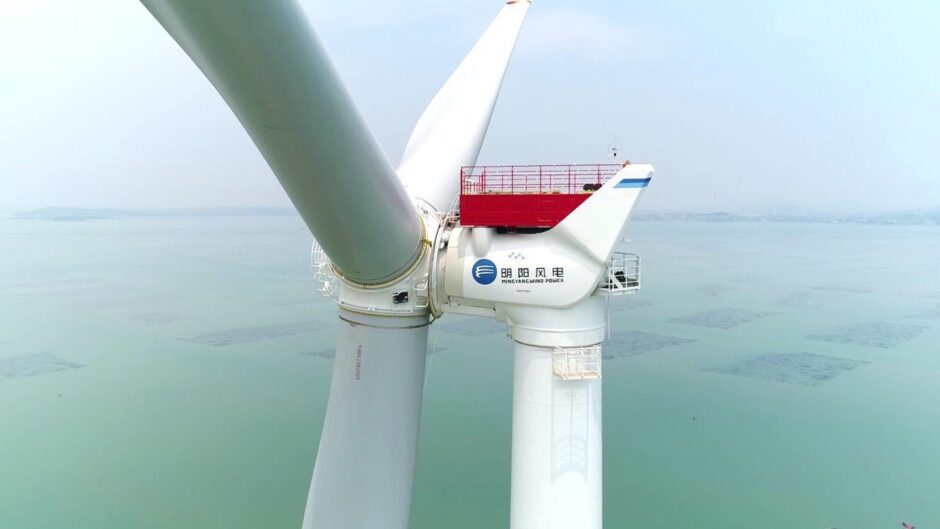Chancellor of the exchequer Rachel Reeves’ recent trip to China has raised fresh concerns about the role of Chinese companies in the UK’s offshore wind industry.
At the conclusion of her recent three-day visit, the UK government announced that both sides aimed to deepen their clean energy partnership.
While light on commitments, the announcement said that the UK and China will promote renewable energy, including offshore wind, and work together to support the global energy transition.
However, the strengthening of UK-China relations has not been universally welcomed.
In comments to the Times, former MI6 chief Richard Dearlove warned of the security threat posed by a Chinese presence in the UK’s renewable energy supply chain.
He warned that Chinese companies, whether state-owned or private, can come under government influence.
“The fact of the matter is every Chinese industry is answerable to the leadership of the communist party,” he said.
“If the order is ‘jump’, the response has to be ‘how high’, they have no options to say no. That’s the difficulty behind the scenes.”
China’s largest private turbine manufacturer, Mingyang Smart Energy (LON:MYSE), has been looking to open a turbine facility in Scotland for several years.
Recently the facility progressed through the Scottish industry-led Strategic Investment Model (SIM) identifying key infrastructure projects required to support Scotland’s offshore wind build out.
The proposed facility in Scotland would mark the biggest presence by a Chinese turbine company in Europe, making it a focus of the role China plays in the UK’s supply chain.
Chinese presence
China is no stranger to the UK’s energy supply chain. State-owned China National Offshore Oil Corporation (CNOOC) currently operates the major Buzzard field, holding a 43.2% stake in it, as well as the Golden Eagle, Scott and Telford fields.
And Ineos sold a 50% stake in itself to PetroChina in 2011, forming Petroineos, which operates the Grangemouth refinery.
These companies have been operating in the UK for years without incident.
And Chinese components and raw materials are an integral part of the global renewable energy supply chain, from wind turbines to solar panels.
With the International Energy Agency (IEA) estimating that China accounts for around 60% of global renewable manufacturing capacity, it’s almost impossible to develop a renewable energy project without some input from the country.
But this outsized position has led to critics painting China as a threat to the UK’s security, and that giving them greater access to the country’s energy infrastructure would give them leverage in the case of worsening relations.
Critics have pointed to China-linked cybersecurity breaches targeting UK politicians and the Electoral Commission in the past.
This led to one MP even called on former prime minister Rishi Sunak to pause and review the application for the Mingyang turbine facility.
Similar concerns about China’s intentions led to the UK government removing China General Nuclear (CGN) from the Sizewell C nuclear plant project, buying the company’s 20% stake in 2022.
While Reeves’ visit suggests a sweetening of UK-China relations, it still comes amid a backdrop of Chinese support for the Russian invasion of Ukraine, looming threats of tariffs against China from US president-elect Donald Trump, and concerns about military action against Taiwan.
With companies controlling the operational software of their turbines, this represents a potential security weakness.
Among Dearlove’s comments were claims that China could “reprogram” components connected to the energy grid.
The fears are that, should relations between China and the UK or the broader West sour, Chinese companies could act under orders from the government to remotely update the turbines, curtailing power supplies or even damaging the transmission network.
Mingyang’s role
All this is weighed against the potential benefits that Mingyang could bring to the UK, such as cheaper turbines and jobs – both tempting to developers facing cost constraints for their projects and governments looking to sell the benefits of renewable energy projects.
While the company has a base in Germany, the facility would also mark Mingyang’s first manufacturing site in Europe, providing access to markets around the North Sea.
Over the last year, the facility has progressed through the Scottish industry-led Strategic Investment Model (SIM), reaching the second assessment stage.
With the UK’s offshore wind sector dominated by European companies such as Vestas and Siemens Gamesa, bringing in an additional company could increase competition, helping drive down prices and removing bottlenecks in the supply chain.
But giving market share to a Chinese company risks undermining the UK’s main suppliers.
And Western authorities are investigating whether China is subsidising its renewable energy manufacturers and exporting its excess capacity at anti-competitively low prices.
This could ultimately reduce competition, driving off other players and leaving the UK beholden to Chinese companies.
“I’m sure the Chinese are absolutely delighted to contribute to the weakening of our industrial base,” Dearlove said. “We’re rushing to create a zero-carbon economy dependent on renewables which will eventually weaken our economic position.”
Relations between the UK and China could deepen when energy secretary Ed Miliband visits the country later this year.
Recommended for you




 © Shutterstock Feed
© Shutterstock Feed © Supplied by CNOOC
© Supplied by CNOOC © Supplied by Mingyang
© Supplied by Mingyang






